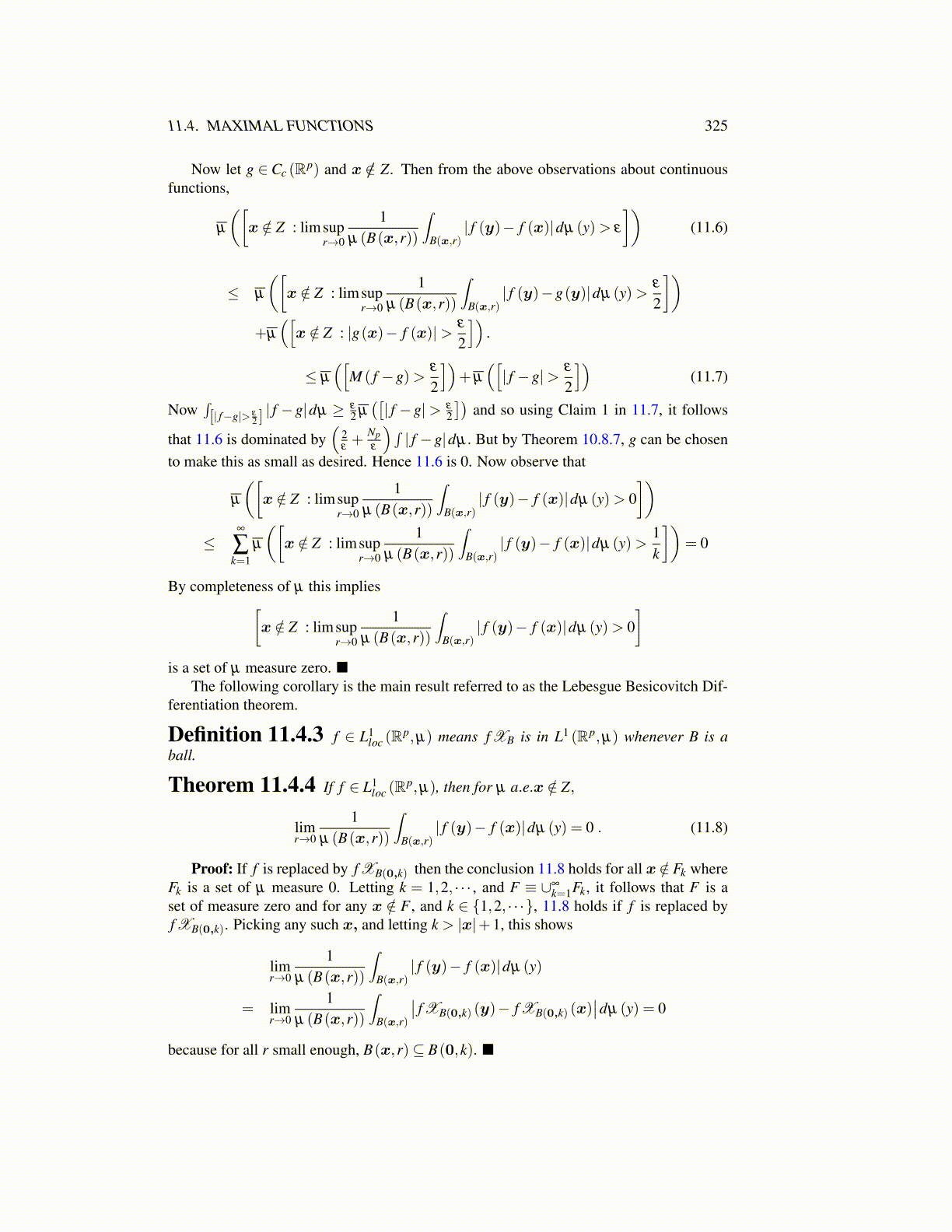
11.4. MAXIMAL FUNCTIONS 325
Now let g ∈ Cc (Rp) and x /∈ Z. Then from the above observations about continuousfunctions,
µ
([x /∈ Z : limsup
r→0
1µ (B(x,r))
∫B(x,r)
| f (y)− f (x)|dµ (y)> ε
])(11.6)
≤ µ
([x /∈ Z : limsup
r→0
1µ (B(x,r))
∫B(x,r)
| f (y)−g(y)|dµ (y)>ε
2
])+µ
([x /∈ Z : |g(x)− f (x)|> ε
2
]).
≤ µ
([M ( f −g)>
ε
2
])+µ
([| f −g|> ε
2
])(11.7)
Now∫[| f−g|> ε
2 ]| f −g|dµ ≥ ε
2 µ([| f −g|> ε
2
])and so using Claim 1 in 11.7, it follows
that 11.6 is dominated by(
2ε+
Npε
)∫| f −g|dµ. But by Theorem 10.8.7, g can be chosen
to make this as small as desired. Hence 11.6 is 0. Now observe that
µ
([x /∈ Z : limsup
r→0
1µ (B(x,r))
∫B(x,r)
| f (y)− f (x)|dµ (y)> 0])
≤∞
∑k=1
µ
([x /∈ Z : limsup
r→0
1µ (B(x,r))
∫B(x,r)
| f (y)− f (x)|dµ (y)>1k
])= 0
By completeness of µ this implies[x /∈ Z : limsup
r→0
1µ (B(x,r))
∫B(x,r)
| f (y)− f (x)|dµ (y)> 0]
is a set of µ measure zero. ■The following corollary is the main result referred to as the Lebesgue Besicovitch Dif-
ferentiation theorem.
Definition 11.4.3 f ∈ L1loc (Rp,µ) means f XB is in L1 (Rp,µ) whenever B is a
ball.
Theorem 11.4.4 If f ∈ L1loc (Rp,µ), then for µ a.e.x /∈ Z,
limr→0
1µ (B(x,r))
∫B(x,r)
| f (y)− f (x)|dµ (y) = 0 . (11.8)
Proof: If f is replaced by f XB(0,k) then the conclusion 11.8 holds for all x /∈ Fk whereFk is a set of µ measure 0. Letting k = 1,2, · · · , and F ≡ ∪∞
k=1Fk, it follows that F is aset of measure zero and for any x /∈ F , and k ∈ {1,2, · · ·}, 11.8 holds if f is replaced byf XB(0,k). Picking any such x, and letting k > |x|+1, this shows
limr→0
1µ (B(x,r))
∫B(x,r)
| f (y)− f (x)|dµ (y)
= limr→0
1µ (B(x,r))
∫B(x,r)
∣∣ f XB(0,k) (y)− f XB(0,k) (x)∣∣dµ (y) = 0
because for all r small enough, B(x,r)⊆ B(0,k). ■